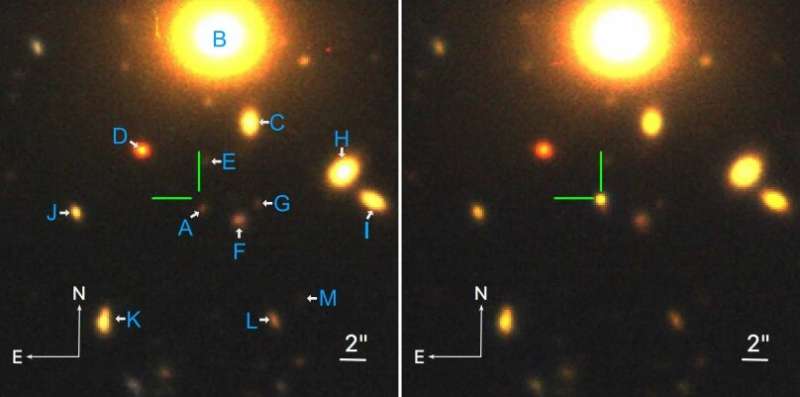July 11, 2019 report
HSC16aay is a Type IIn supernova, study suggests

New research presented by an international team of astronomers suggests that a recently detected transient, designated HSC16aay, is a Type IIn supernova. A research paper reporting the discovery and detailing the finding, was published July 2 on the arXiv pre-print server.
HSC16aay was first identified by the Subaru/Hyper Suprime-Cam (HSC) transient survey as part of Subaru Strategic Program (SSP) during observations conducted between November 2016 and April 2017. Subsequent observations of this transient have shown that its light curve evolved very slowly and that the apparent nearest galaxy on the sky had a photometric redshift of 1.45. Taking into account these two facts, the researchers believe that HSC16aay may be a high-redshift supeluminous supernova (SN).
In order to verify this assumption, a group of astronomers led by Takashi J. Moriya of National Astronomical Observatory of Japan (NAOJ) has performed follow-up observations of HSC16aay using the HSC instrument and the Gemini South telescope in Chile. The results provided more evidence suggesting the supernova nature of this source.
"Spectra of HSC16aayt show a strong narrow emission line and we classify it as a Type IIn supernova," the astronomers wrote in the paper.
This conclusion of Moriya's team is due to the fact that Type IIn supernovae are a subclass of hydrogen-rich SNe showing narrow emission lines in their spectra. Astronomers assume that these narrow lines originate from the interaction between ejecta from supernovae and dense circumstellar media (CSM) formed by the progenitors before their explosion.
In particular, when it comes to the properties of HSC16aay's light curve, the researchers found the peak optical magnitude at likely around −19.9 mag, which is common for Type IIn supernovae. The transient shows a very slow photometric evolution with a rise time of over 100 days, and the optical magnitude change in 400 days remains within 0.6 mag. The redshift of HSC16aay was measured to be approximately 0.68.
In general, the astronomers noted that overall properties of HSC16aayt (which received supernova designation SN 2016jiu) are similar to those of the other Type IIn supernova known as SN 2008iy, but HSC16aayt was found to be more luminous.
Furthermore, the location of HSC16aayt was calculated at about 16,300 light years away from its host galaxy center. According to the authors of the study, such a relatively large distance may indicate that the object is an isolated Type IIn SN, however, other explanation cannot be excluded.
"HSC16aayt might be another example of isolated Type IIn supernovae, although the possible existence of underlying star-forming activity of the host galaxy at the supernova location is not excluded," the astronomers concluded.
They added that at the moment it is difficult to determine the shape and orientation of the host galaxy. Therefore, the star-forming activity scenario remains plausible if these properties are uncertain.
More information: Takashi J. Moriya et al. Slowly evolving interacting transient rising for more than 100 days arXiv:1907.01633v1 [astro-ph.HE]: arxiv.org/abs/1907.01633 HSC16aayt
© 2019 Science X Network





















